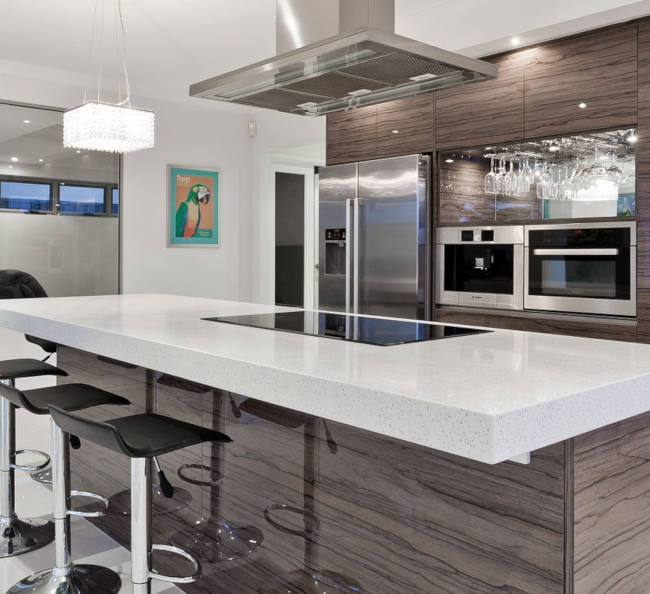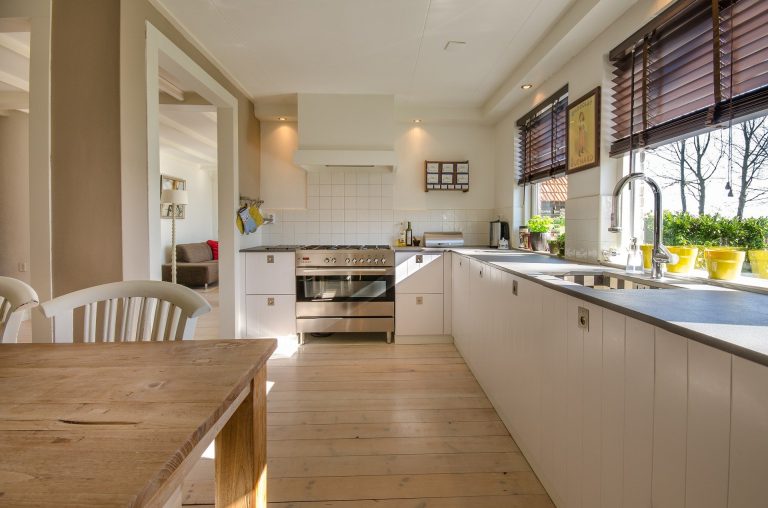Buying a new kitchen is a major investment, both financially and emotionally. It is important to take the time to plan carefully and make the right decisions to ensure that you get the kitchen of your dreams.
Step 1: Set a budget
The cost and timeline for a new kitchen in the UK will vary depending on a number of factors, including the size of your kitchen, the materials you choose, the scope of the work, and your location. However, as a general guide, you can expect to pay between £5,000 and £12,000 for a new kitchen, and the project will take between 2 and 4 weeks to complete. Once you have a general idea of the cost, add a 10-20% contingency fund to your budget to cover unexpected costs.
Step 2: Choose a layout
Once you have a budget in mind, you can start to think about the layout of your new kitchen. The layout should be functional and efficient, and it should take into account your lifestyle and cooking habits. Consider the work triangle, storage, counter space, and island when planning your layout.
Here are some of the most popular kitchen layouts in the UK:
Galley: Galley kitchens are a good choice for small kitchens. They are narrow and have two parallel runs of cabinets and appliances. Galley kitchens can be very efficient, as everything is within reach. L-shaped: L-shaped kitchens are a good choice for medium-sized kitchens. They have two runs of cabinets and appliances that form an L-shape. L-shaped kitchens offer a good balance of counter space and storage space. U-shaped: U-shaped kitchens are a good choice for large kitchens. They have three runs of cabinets and appliances that form a U-shape. U-shaped kitchens offer the most counter space and storage space, but they can also be the most expensive. Island: Island kitchens are a good choice for medium-sized to large kitchens. They have a central island that can be used for cooking, preparation, or dining. Island kitchens can be a great way to create a social and inviting space in your kitchen. Peninsula: Peninsula kitchens are a good choice for medium-sized to large kitchens. They have a peninsula that extends from the wall into the kitchen. Peninsula kitchens can be a good way to create a functional and stylish kitchen without taking up too much space.Step 3: Select your materials
The materials you choose will have a big impact on the overall look and feel of your kitchen, as well as the cost. Popular kitchen materials include wood, laminate, thermofoil, granite, quartz, marble, and laminate.
When selecting materials for a new kitchen in the UK, there are a few factors to consider:
Budget: The cost of materials will vary depending on the type of material you choose, as well as the quality and brand. It is important to set a budget before you start shopping so that you can narrow down your choices. Durability: Kitchens are high-traffic areas, so it is important to choose materials that are durable and can withstand wear and tear. Some materials, such as quartz and granite, are more durable than others, such as laminate and wood. Style: Kitchens are also a reflection of your personal style, so it is important to choose materials that you love. There are a wide variety of materials available, from traditional to modern, so you can find something to suit your taste. Maintenance: Some materials require more maintenance than others. For example, wood countertops need to be sealed regularly, while quartz and granite countertops are relatively low-maintenance.Here is a brief overview of some of the most popular kitchen materials in the UK:
Cabinets: Cabinet doors and frames can be made from a variety of materials, including wood, laminate, and MDF. Wood is the most expensive option, but it is also the most durable and stylish. Laminate and MDF are more affordable options, but they are not as durable or stylish as wood. Countertops: Quartz and granite are the most popular countertop materials in the UK. They are both durable, stylish, and low-maintenance. Other countertop materials include laminate, wood, and stainless steel. Flooring: Tile is the most popular flooring material for kitchens in the UK. It is durable, easy to clean, and available in a wide variety of colors and styles. Other flooring materials include hardwood, vinyl, and laminate.Step 4: Hire a contractor
Once you have chosen your materials and layout, it is time to hire a contractor. Be sure to get quotes from multiple contractors and check their references before making a decision and if there registered with organisations like Federation of Masterbuilders. It is also important to get everything in writing, including the scope of work, the timeline, and the cost.
Step 5: Demolish and construct your new kitchen
The demolition and construction phase of a kitchen renovation can be the most disruptive, but it is also the most rewarding. Be sure to have a plan for where you will stay and cook while your kitchen is being renovated. You should also be prepared for unexpected delays and costs.
Plan your project. This includes deciding on the layout of your new kitchen, the materials you want to use, and the appliances you want to install. You may also want to hire a kitchen designer to help you with this process.
Get the necessary permits. If you are making any structural changes to your kitchen, you will need to obtain a building permit from your local authority. You may also need to obtain other permits, such as an electrical permit or a plumbing permit.
Demolition. The first step is to demolish your existing kitchen. This includes removing the cabinets, countertops, appliances, and flooring.
Construction. Once the demolition is complete, the contractor can start constructing your new kitchen. This includes installing the cabinets, countertops, appliances, and flooring.
Finishing touches. Once the construction is complete, the contractor will add the finishing touches, such as installing the sink and faucet, backsplash, and lighting.
Step 6: Add the finishing touches
The finishing touches are what can really make a new kitchen shine. They are the details that add personality and style, and that make the kitchen feel like a complete and inviting space.
Lighting: Lighting is one of the most important finishing touches in any room, but it is especially important in the kitchen. Make sure to have a variety of lighting sources, including task lighting for workspaces, ambient lighting for general illumination, and accent lighting to highlight focal points. Hardware: The hardware on your cabinets and drawers can make a big difference in the overall look of your kitchen. Choose hardware that complements your cabinets and countertops, and that is also functional and easy to use. Accessories: Accessories can add a touch of personality and style to your kitchen. Consider adding things like a fruit bowl, a vase of flowers, or a set of cookbooks to your countertops. You can also add artwork or mirrors to the walls. Plants: Plants are a great way to add life and color to your kitchen. Choose plants that are easy to care for and that can tolerate the humidity and heat of a kitchen environment. Flooring: The flooring in your kitchen is another important finishing touch. Choose flooring that is durable and easy to clean. You may also want to consider adding a rug to add warmth and comfort to the space.Tips for getting a new kitchen
- Take advantage of government grants. The UK government offers a number of grants to help homeowners with the cost of energy efficiency improvements. You may be eligible for a grant to help with the cost of installing energy-efficient appliances or countertops in your new kitchen.
- Consider hiring a kitchen designer. If you are not sure where to start with designing your new kitchen, you may want to consider hiring a kitchen designer. A kitchen designer can help you create a functional and stylish kitchen that meets your needs and budget.
- Don’t be afraid to negotiate with contractors. Once you have gotten quotes from multiple contractors, be sure to negotiate with them to get the best possible price.
- Be prepared for unexpected costs. Things don’t always go according to plan during a renovation. Be prepared for unexpected costs, such as the need to replace old or damaged electrical wiring or plumbing.
Conclusion
Getting a new kitchen can be a lot of work, but it is also a great way to improve your home and make it more enjoyable. By following these tips, you can get the kitchen of your dreams without breaking the bank.
Additional tips:
- Think about the future. When designing your new kitchen, think about how you may use it in the future. Will you have a growing family? Will you need to make any accessibility modifications as you age? Consider your needs for the next 10-20 years when making decisions about layout and features.
- Don’t be afraid to be creative. Your kitchen is a personal space, so don’t be afraid to put your own stamp on it. Choose materials and finishes that reflect your style, and don’t be afraid to mix and match different elements.
- Pay attention to the details. The small details can make a big difference in the overall look and feel of your kitchen. Don’t forget to think about the hardware, lighting, and other finishing touches.
Getting a new kitchen is a big decision, but it can also be a lot of fun. By taking the time to plan carefully and make the right decisions, you can create a kitchen that you will love for years to come.


